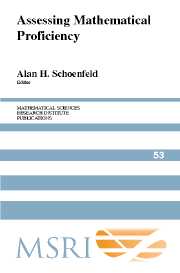Book contents
- Frontmatter
- Contents
- Preface
- Acknowledgments
- Section 1 The Big Picture
- Section 2 Perspectives on Mathematical Proficiency
- Section 3 What Does Assessment Assess? Issues and Examples
- Section 4 The Case of Algebra
- 11 Assessing the Strands of Student Proficiency in Elementary Algebra
- 12 Making Meaning in Algebra: Examining Students' Understandings and Misconceptions
- 13 Task Context and Assessment
- Section 5 What Do Assessments Assess? The Case of Fractions
- Section 6 The Importance of Societal Context
- Epilogue: What Do We Need to Know? Items for a Research Agenda
- About the Authors
- Subject Index
- Author Index
- Task Index
13 - Task Context and Assessment
Published online by Cambridge University Press: 06 July 2010
- Frontmatter
- Contents
- Preface
- Acknowledgments
- Section 1 The Big Picture
- Section 2 Perspectives on Mathematical Proficiency
- Section 3 What Does Assessment Assess? Issues and Examples
- Section 4 The Case of Algebra
- 11 Assessing the Strands of Student Proficiency in Elementary Algebra
- 12 Making Meaning in Algebra: Examining Students' Understandings and Misconceptions
- 13 Task Context and Assessment
- Section 5 What Do Assessments Assess? The Case of Fractions
- Section 6 The Importance of Societal Context
- Epilogue: What Do We Need to Know? Items for a Research Agenda
- About the Authors
- Subject Index
- Author Index
- Task Index
Summary
Introduction
In this chapter, I will explore the impact of task context on assessment in mathematics. It is nontrivial to determine the understandings measured by a given assessment, so a close examination of some tasks and what they reveal is the main focus of this paper. Before considering these contemporary explorations, and in order to establish for the reader that the context of a mathematics task is indeed a salient feature, I will review findings from research in mathematics education and psychology. I will show that the role of context in mathematics assessment is a complex issue that involves much more than capturing the interest and harnessing the motivation of the student.
Background
Keeping it real. Over the past several decades, many different researchers and educators have pointed out the benefits of setting mathematical tasks in rich, attractive, and realistic contexts (e.g., [de Lange 1987; Freudenthal 1983]). Realistic contexts are generally regarded as referring to aspects of the “real” social or physical world as well to fictional, imaginary, or fairy-tale worlds. Specifically, there are no restrictions on the contexts that can be called realistic as long as they are meaningful, familiar, appealing, and morally appropriate for students. In the literal sense, it is not the degree of realism that is crucial for considering a context as realistic, but rather the extent to which it succeeds in getting students involved in the problem and engages them in meaningful thinking and interaction.
- Type
- Chapter
- Information
- Assessing Mathematical Proficiency , pp. 177 - 192Publisher: Cambridge University PressPrint publication year: 2007
- 2
- Cited by



